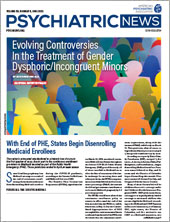The number of stimulant medication prescriptions in the United States is rising for a variety of indications and among many patient populations, including older adults. The majority of stimulants being prescribed belong to the amphetamine and methylphenidate class of drugs. An
observational cohort study appearing in
The Lancet in August 2022 led by Shannon Brumbaugh, M.D., revealed that stimulant prescribing in the United States between 2010 and 2020 has increased in patients of all ages and that the average age of recipients increased throughout their study.
The results further indicated that among adults 65 and older, there was an increase in stimulant prescriptions for people with multiple cardiovascular risk factors. Stimulants act on the central nervous system to increase attention, improve mood, and elevate energy. However, their effects on monoamine transmission may cause an increase in resting heart rate and systolic blood pressure, thereby increasing risk for those with preexisting cardiovascular disease. This concern is supported by findings from
another cohort study—this one was led by Mina Tadrous, Pharm.D., Ph.D., and published in
JAMA Network Open in October 2021. The team found a 40% increase in cardiovascular events among 6,457 older adults within 30 days of initiation of a stimulant.
There are many reasons for increased prescribing of stimulants to older adults. Increased awareness and acceptance of attention-deficit/hyperactivity disorder (ADHD) have contributed to an increase in diagnoses; however, ADHD diagnoses alone do not account for the increase in stimulant prescribing. Some stimulant prescriptions are approved for treatment of narcolepsy and short-term adjunct treatment of weight loss in obese patients. Other conditions for which off-label use of stimulant medication may yield significant benefits include fatigue, traumatic brain injury, poststroke recovery, treatment-resistant depression, Parkinson’s disease, and major neurocognitive disorder.
There is a dearth of studies on the use of stimulants in older adults, so it is challenging to predict adverse effects. But given the potential risks associated with stimulant prescribing in an older population that is inherently at greater risk for cardiovascular events, careful initial screening and monitoring of blood pressure and heart rate are recommended. Routine urine drug screening is also recommended to ensure compliance as well as to minimize prescribing to patients who are taking other controlled medications that may potentiate the risk for cardiovascular events. An electrocardiogram is not routinely needed before starting a stimulant unless the patient has a history of congenital heart disease, cardiac surgery, heart failure, heart murmur, palpitations, chest pain, hypertension, shortness of breath on exertion, and other medical conditions that increase cardiac risk.
Stimulants are also relatively contraindicated in patients with severe vascular or cardiovascular diseases, hyperthyroidism, epilepsy, glaucoma, drug abuse, agitation, and psychosis. They can decrease the metabolism of many drugs, including tricyclic antidepressants, warfarin, phenytoin, primidone, and phenobarbitone. Co-administration of stimulants with monoamine oxidase inhibitors can cause life-threatening hypertensive crises and increase the risk for serotonin syndrome when combined with serotonergic drugs like most antidepressants.
Gastrointestinal and urinary pH affects the absorption and elimination of the amphetamine class of stimulants. Gastrointestinal acidifying agents such as ascorbic acid and fruit juices and urinary acidifying agents such as ammonium chloride can lower amphetamine plasma levels; gastrointestinal alkalinizing agents such as sodium bicarbonate and urinary alkalinizing agents such as acetazolamide and thiazides can lower amphetamine plasma levels.
To minimize adverse effects, clinicians should start stimulants in older adults at the lowest dose and gradually increase until potential benefits are reached while monitoring for side effects. For example, methylphenidate can be started at 5 mg in the morning and then increased by 5 mg weekly based on the improvement of symptoms. Lower doses of stimulants are usually therapeutic in older adults. A second dose can be given in the mid-afternoon to avoid insomnia.
As required by the Drug Enforcement Administration, Schedule II stimulants (amphetamines and methylphenidates) can be prescribed by a qualified medical professional with multiple prescriptions to a total of up to a 90-day supply as long as the state laws are met and there is no undue risk of diversion or abuse. Each prescription must have written instructions for the earliest date on which the pharmacy can refill each prescription. Clinicians should also check the Prescription Monitoring Drug Program to ensure that patients are not misusing or overusing the stimulants. The risk of diversion and abuse of the stimulants should be evaluated during patient encounters.
Clinicians should also conduct due diligence in monitoring medical comorbidities, medication changes in older adults, and patients’ ability to manage their medications. The dosage of stimulants should be re-evaluated for drug-drug interactions as well as for side effects and changes in physiology with aging. Patients with impaired liver and renal function should be prescribed the lowest possible dose. Drug holidays can be used to reduce the frequency of dosing.
To discontinue the medications, clinicians should gradually taper the dose until it is stopped. Abrupt cessation of stimulants can cause withdrawal symptoms of dysphoria, depression, fatigue, and sleep disturbances. If the indication for which the stimulant was prescribed still needs to be addressed, nonamphetamine stimulants like modafinil and armodafinil and nonstimulant medications for ADHD like atomoxetine, guanfacine, clonidine, and bupropion can be prescribed. ■

